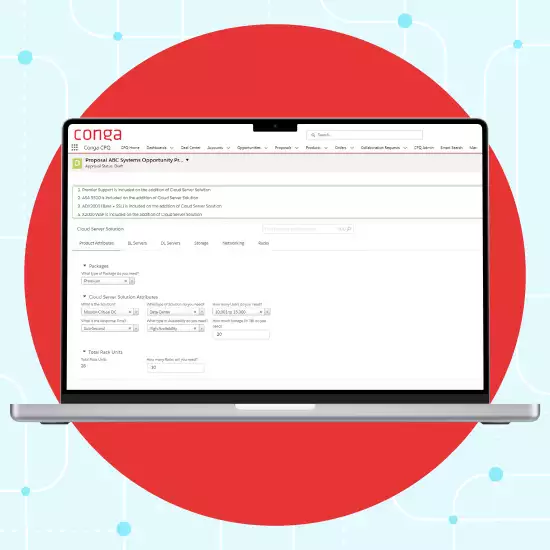
CPQ playbook: maximizing revenue from B2B eCommerce
FREE PLAYBOOK
Maximizing revenue from B2B eCommerce
The evolution of eCommerce is fundamentally reshaping the B2B landscape, driven by rapid technological advancements and changing buyer preferences. With the global B2B eCommerce market—valued at $7.432 billion in 2022—projected to reach a staggering $36.107 trillion by 2031, it’s clear that businesses must embrace transformation and adopt a digital-first approach if they want to secure their position in this evolving marketplace.

Two primary factors have contributed to this exponential growth:
- Increasing preference for multi-channel purchasing. Today’s B2B buyers often conduct extensive online research before making a purchase decision, and they expect a seamless experience across every platform. This requires companies to create integrated experiences that span online catalogs, mobile applications, and traditional sales channels. Businesses that can provide a cohesive journey are likely to enhance customer loyalty and streamline sales processes.
- The rise of digital platforms. Modern B2B buyers have been empowered to seek greater transparency and efficiency in their purchasing processes. Online marketplaces and advanced procurement solutions let buyers easily compare options, negotiate terms, and finalize purchases. In fact, Gartner reports that 83% of buyers prefer to order or pay through a digital commerce channel. This overwhelming preference highlights a unique opportunity to increase sales and improve customer satisfaction by catering to the evolving expectations of B2B buyers.
Businesses that are willing to innovate are well-positioned to reap the benefits of digital transformation. By embracing eCommerce technology and trends, companies can expand their reach into new markets, streamline operations, and enhance customer engagement. As the global marketplace continues to evolve, businesses that capitalize on these opportunities are likely to thrive in an increasingly competitive environment. Adapting to change is no longer optional—it is imperative for sustained growth and success in the modern economy.
In this playbook, we’ll dig into the multitude of revenue opportunities afforded by B2B eCommerce and the challenges of capturing that revenue. We will also provide actionable insights to help you build a revenue-focused eCommerce strategy and achieve sustainable B2B growth.
Understanding the B2B buyer mindset
Today’s business buyers are remarkably similar to individual consumers. They want to buy where, when, and how they choose—and they expect business transactions to deliver the same frictionless experience as everyday B2C purchases. For example:
- B2B buyers increasingly want to handle the entire buying processes—including configuring, quoting, and ordering—without involving a sales representative. Self-service portals are no longer a nice-to-have, they’re expected—even for large purchases. A recent McKinsey study found that 15% of corporate decision makers are willing to make purchases over $1 million online.
- Personalization is now a baseline expectation—and that doesn’t mean simply greeting a customer by name. When generating a self-service quote, buyers expect to see personalized product recommendations and pricing based on their purchase history, purchase volume, and relationship to the seller.
Long story short, B2B buyers expect a streamlined, transparent, and highly personalized buying process—and they demand the flexibility and convenience they’ve come to rely on for consumer transactions.
Revenue opportunities in B2B commerce
B2B business strategy tends to focus on diversifying income through multiple revenue streams to maximize revenue growth, increase customer lifetime value, and mitigate risk.
B2B revenue streams typically fall into four major categories:

- Simple goods (bulk products, parts, and accessories)
- Complex goods (intricate, configurable products)
- Digital goods and subscriptions (SaaS, Xaas, etc.)
- Professional services and maintenance
Traditional B2B eCommerce transactions revolve around one-time product sales, ranging from bulk order of materials to highly specialized and configurable industrial equipment. In addition to physical products, B2B companies often offer supplemental services, including:
- Installation
- Maintenance
- Customer support
- Training and enablement
For complex B2B sales (like enterprise software or heavy machinery), companies may create an additional revenue stream by selling add-ons like consulting services to support implementation, customization, or integration. Long-term service contracts may also be offered for ongoing managed services (e.g., IT management, cloud hosting, supply chain optimization)—helping to further embed the company into its customers’ operations.
In recent years, the subscription model has become a critical component of B2B eCommerce, allowing businesses to build a predictable, consistent revenue stream. Both products and services can be offered on a subscription basis—for example, SaaS technology, maintenance services, or consumable products that require replenishment.
These recurring revenue models provide consistent and predictable cash flow, which leads to better financial forecasting, more stable operations, and more effective resource planning. As an added benefit, recurring revenue from subscriptions typically leads to higher customer lifetime value, because subscribers are more likely to stay engaged with the brand long-term—providing more opportunities for cross-sells, upsells, and renewals.
That said, the advantages of the subscription model are not entirely one-sided. Customers also benefit as they seek flexibility and risk sharing in their business relationships. With a subscription service, expenses are more predictable and can be shifted from capital expenditure to operational expenditure.
Challenges in capturing B2B eCommerce revenue
As we’ve discussed, the wants and needs of B2B buyers are changing—and companies have a lot more revenue streams to manage than ever before. This inevitably leads to increased complexity and significant challenges for a business.
- Combining traditional go-to-market channels and personalized digital revenue streams makes it more difficult to manage revenue flow—especially when some revenue streams are recurring and others are one-time transactions.
- Maximizing B2B revenue requires an optimized sales process. Common challenges in achieving this goal include:
- Complex product configurations
- Convoluted pricing and discounting rules
- Delays in quote delivery
- Quoting errors
- Siloed business systems
- Inaccurate or inconsistent data
- Outdated, manual processes
The only way to overcome these barriers to revenue and deliver the cohesive omnichannel experience customers desire is by developing a revenue-focused strategy.
Building a revenue-optimized B2B eCommerce strategy
Once you understand the basics of B2B eCommerce, it’s tempting to assume that any solution will work for a given business. However, just like in B2C commerce, the B2B environment is simply too complex for a one-size-fits-all approach.
Each organization requires a solution tailored to its unique business model, industry, product line, geography, customer profile, and partners—and one that can evolve with the business as those factors change. In addition, the solution must support modern selling techniques like custom pricing, personalized recommendations, and self-service portals. And the buying experience—including pricing and product configuration rules—must remain consistent across every digital commerce channel to avoid confusion for customers and partners.
Data consistency is the key to addressing all these complex needs successfully. A digital commerce solution that is built on a unified data model can:
- Ensure that all channels connect to a single source of truth, allowing for a cohesive experience at every touchpoint
- Improve the customer experience by eliminating discrepancies in product and pricing data
- Enable easy re-order of previously purchased items
- Simplify system management to reduce the total cost of ownership
- Eliminate friction in cross-selling and upselling
CPQ: what it is and how it works
CPQ (configure, price, quote) software is designed to empower sales teams, partners, and customers to configure complex product and service offerings accurately and efficiently. CPQ allows companies to automate the entire sales cycle with defined processes to drive faster and more accurate quotes. Pre-configured guardrails ensure teams only sell using the latest pricing, and built-in rules help to avoid rogue discounting.
Processes that can be automated with CPQ include:
- Product configurations, with guided selling tools to ensure accuracy
- Pricing, with built-in business rules to apply the right discount or contracted price
- Approvals—which can move more quickly with rules and guardrails in place
- Cross-sell and upsell, with opportunities identified automatically
- Offer delivery in hours rather than days, to help close more deals
The role of CPQ technology in B2B eCommerce
A CPQ solution is critical to automate the online sales process and deliver a seamless omnichannel buying experience. CPQ technology allows companies to create a centralized repository for product information, pricing rules, and customer history. It also eliminates the need for multiple platforms and data sets to support varied selling scenarios (self-service, direct sales, partner sales) and customer support interactions.
By leveraging a CPQ system as the single, unified data source, companies can create a more efficient and profitable sales process. Just as importantly, they can deliver a richer buying experience for customers by allowing them to move effortlessly between channels and make their desired purchases without added friction.
Implementing a CPQ solution for B2B eCommerce offers countless advantages. In the following sections, we’ll explore three of the most important benefits.

Advantage 1: CPQ supports recurring revenue models
Recurring revenue is essential to modern B2B commerce strategies—and CPQ is essential to managing subscription-based processes effectively. Here’s how:
- Simplify complex offerings. To build a successful subscription model, businesses must design offerings that appeal to their unique audience—whether that means product subscriptions, service subscriptions, or a hybrid. With CPQ integrated into the eCommerce platform, companies can easily manage complex subscription tiers, volume-based discounts, and loyalty rewards—ensuring accurate pricing every time.
- Streamline billing processes. Offering flexible billing options (e.g., monthly, quarterly, or annually) allows customers to better manage their budget and cash flow—and may help with customer retention. Automating renewals and offering incentives for early renewal can also help to reduce churn. CPQ simplifies all these complexities—and it also allows companies to combine one-time sales and subscription purchases into a single invoice to enhance the customer experience.
- Maximize revenue opportunities. CPQ’s robust data analytics capabilities empower companies to optimize their eCommerce revenue and identify upsell opportunities. Personalized offers—such as additional features or advanced support—can be suggested automatically through the eCommerce platform.
- Increase lifetime value. Offering complementary products and services can increase per-customer revenue—and deepen customer relationships. By creating business rules within the CPQ system, the eCommerce platform can automatically suggest relevant add-ons to ensure that no revenue opportunity is missed—even in self-service scenarios.
Advantage 2: CPQ enhances the customer experience
In today’s competitive market, a high-quality customer experience is directly linked to revenue growth. In fact, Gartner reported that creating a better customer experience is the number one reason companies choose to launch B2B digital commerce offerings.
Unfortunately, traditional eCommerce platforms are insufficient to support this customer-centric vision, as they are typically extensions of an ERP (enterprise resource planning) system focused on accounting capabilities and inflexible transactions. A modern CPQ solution, on the other hand, sits between a company’s CRM (customer relationship management) and ERP platforms to deliver a seamless experience across the entire customer journey.
For self-service customers, a CPQ solution provides tools to guide the buying decision, such as:
- Configuration suggestions
- Related product recommendations
- Visualizations
- Additional resources
CPQ automatically calculates pricing based on pre-negotiated rates, current promotions, and applicable discounts. This reduces the risk of inconsistent data across channels and enables customers to make a purchase without help from a sales rep.
Advantage 3: CPQ offers scalability for the future
Expanding your existing business model to support new channels (like self-service) or revenue streams (like subscriptions) can be difficult and time consuming without a flexible CPQ solution that can grow with your strategy. A scalable infrastructure is pivotal to enabling B2B eCommerce businesses to handle increased complexity, grow revenue streams, and adapt to changing market conditions.
CPQ is part of a holistic revenue lifecycle management (RLM) strategy, which provides a framework for unifying business processes and accelerating scalability. A RLM strategy ensures that data is integrated, so a company’s CLM, CPQ, ERP, eCommerce, order management, and billing systems can work from a shared data model. This integrated approach helps businesses handle more channels, higher transaction volumes, and more complex revenue streams without compromising data integrity.
- Cloud-based technology and APIs are another critical element of long-term flexibility. APIs help to future-proof the business by:
- Hosting embedded experiences directly into any website, portal, or application for a more seamless customer experience
- Expanding data sourcing with the ability to populate data from any CRM, ERP, or system of record
- Reducing total operating cost by consolidating to a single vendor, regardless of your preferred CRM, ERP, or data source
- Improving ease of use, as industry-standard REST APIs are easy to develop and maintain, providing flexibility to support growth
The right technology to streamline eCommerce processes
If you’re looking for a comprehensive solution that supports recurring revenue models, enhances customer experience, and grows along with your business, you’ve come to the right place. Conga CPQ offers robust, flexible, and scalable features designed to meet the complex needs of today’s B2B organizations.

For enterprise companies looking to add new selling channels, Conga Digital Commerce is an extension to our already powerful CPQ technology. It empowers businesses to provide an omnichannel platform for customers and partners, utilizing a single data model and a single configuration/pricing engine across all channels. Conga Digital Commerce supports the configuration and pricing of complex products and services, considering contractual agreements, pricing, and discount approvals—creating higher margin deals and supporting the ways your customers want to buy.
6 reasons to choose Conga
With Conga solutions, companies can drive profitable B2B eCommerce sales with quick, accurate quotes and pricing—no matter how complex their product catalog may be. Here’s how:
- Deliver a unified commerce experience
Offer buyers a seamless experience that can start in one channel and be completed in another, providing a smooth flow of sales engagement. Lower the risk of data inconsistency across rules, pricing, and catalog information. - Guide users to the optimal solution
Help users configure the correct product for their needs—at a fair price—while maintaining your desired margins. Guided configurations and suggested add-ons help to quickly determine the best product configuration based on the customer’s needs. - Support new business models
Conga CPQ supports evolving business models that incorporate multiple solutions (product, service, subscription, usage, etc.) on a single order. - Automate subscription management
Automate subscription renewals—including cross-sell and upsell suggestions—to improve efficiency, increase revenue opportunities, and ensure that renewals are never missed. - Integrate all selling processes
Provide a better customer experience by unifying all touchpoints in the buyer’s journey, ensuring the same configuration and pricing across all customer interactions. - Optimize revenue lifecycle management
Conga CPQ is the only CPQ solution that can align operations across the entire revenue lifecycle, by utilizing a single data model to create a continuous workflow from quote to cash.
Take the next step to maximize revenue
Today’s B2B revenue model looks nothing like it did in the past. Buyer behavior and needs have changed. New pricing models and selling scenarios have emerged. And technology has evolved. To keep up with the new age, businesses must transform their quote and sales process.
If you're ready to start the journey toward modern B2B eCommerce, Conga is here to help. Conga CPQ captures your entire quote-to-cash process on a single platform, so you can manage unlimited solution configurations and generate the perfect quotes every time. And as part of our end-to-end Revenue Lifecycle Management platform, Conga CPQ integrates seamlessly with our other solutions, allowing you to:
- Automate document generation
- Collect eSignatures
- Invoice accurately
- Align contracts with negotiations
See our CPQ demo to learn how Conga can be your partner in driving revenue growth.
FREE PLAYBOOK



